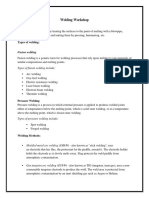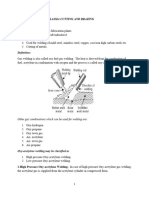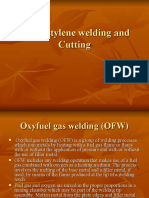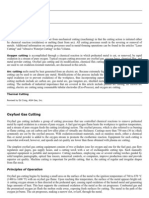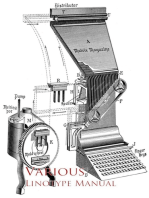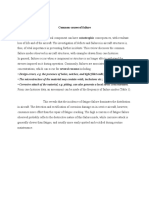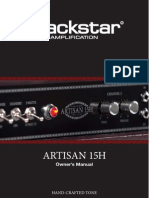GJ 11
GJ 11
Uploaded by
vijayakumarCopyright:
Available Formats
GJ 11
GJ 11
Uploaded by
vijayakumarOriginal Description:
Original Title
Copyright
Available Formats
Share this document
Did you find this document useful?
Is this content inappropriate?
Copyright:
Available Formats
GJ 11
GJ 11
Uploaded by
vijayakumarCopyright:
Available Formats
OXYACETYLENE WELDING, OXY WELDING, OR GAS WELDING
Gas Welding:
Oxy-fuel welding (commonly called oxyacetylene welding, oxy welding, or gas
welding) and oxy-fuel cutting are processes that use fuel gases and oxygen
to weld and cut metals, respectively.
French engineers Edmond Fouch and Charles Picard became the first to develop
oxygen-acetylene welding in 1903.[1] Pure oxygen, instead of air, is used to increase
the flame temperature to allow localized melting of the workpiece material (e.g. steel)
in a room environment.
Basic Requirements:
The equipment used in gas welding consists basically of an oxygen source and a fuel
gas source (usually cylinders), two pressure regulators and two flexible hoses (one of
each for each cylinder), and a torch.
This sort of torch can also be used for soldering and brazing.
The cylinders are often carried in a special wheeled trolley.
The regulator is used to control pressure from the tanks to the required pressure in the
hose.
The flow rate is then adjusted by the operator using needle valves on the torch.
Accurate flow control with a needle valve relies on a constant inlet pressure to it.
Most regulators have two stages: the first stage of the regulator is a fixed-pressure
regulator whose function is to release the gas from the cylinder at a constant
intermediate pressure, despite the pressure in the cylinder falling as the gas in the
cylinder is used.
Regulator
This is similar to the first stage of a scuba-diving regulator. The adjustable second
stage of the regulator controls the pressure reduction from the intermediate pressure
to the low outlet pressure.
The regulator has two pressure gauges, one indicating cylinder pressure, the other
indicating hose pressure.
The adjustment knob of the regulator is sometimes roughly calibrated for pressure,
but an accurate setting requires observation of the gauge.
Some simpler or cheaper oxygen-fuel regulators have only a single stage regulator, or
only a single gauge.
A single-stage regulator will tend to reduce its outlet pressure as the cylinder is
emptied, requiring manual readjustment.
For low-volume users, this is an acceptable simplification.
Welding regulators, unlike simpler LPG heating regulators, retain their outlet (hose)
pressure gauge and do not rely on the calibration of the adjustment knob.
The cheaper single-stage regulators may sometimes omit the cylinder contents gauge,
or replace the accurate dial gauge with a cheaper and less precise "rising button"
gauge.
The hoses are specifically designed for welding and cutting metal.
The hose is usually a double-hose design, meaning that there are two hoses joined
together.
These hoses are color-coded for visual identification and their threaded connectors
are handed to avoid accidental mis-connection
Oxygen is right-handed as normal, fuel gases use a left-handed thread.
These left-handed threads also have an identifying groove cut into their nuts.
Color-coding of hoses varies between countries. In the USA, oxygen is green, and the
fuel hose is red.
In the UK, the oxygen hose is blue (black hoses may still be found on old equipment),
and the acetylene fuel hose is red.
Where LPG fuel, such as propane, is used, the fuel hose should be orange, indicating
that it is compatible with LPG.
LPG will damage an incompatible hose, including most acetylene hoses.
Connections between flexible hoses and rigid fittings are made by a crimped hose
clip over a barbed spigot.
Often referred to as 'O' clips. The use of worm-drive or Jubilee clips is specifically
forbidden in the UK.
The hoses should also be clipped together at intervals approximately 3 feet apart.
(Not recommended for cutting applications.
Because beads of molten metal given off by the process can become lodged between
the hoses where they are held together, and burn through releasing the pressurized gas
inside, which in the case of fuel gas usually ignites).
Gas hoses
Non-return valve
Acetylene is not just flammable, in certain conditions it is also an explosive.
Although it has an upper flammability limit in air of 81%,[5] acetylene's explosive
decomposition behaviour makes this irrelevant.
If a detonation wave enters the acetylene tank, the tank will be blown apart by the
decomposition.
Ordinary check valves that normally prevent back flow can not stop a detonation
wave as they are not capable of closing before the wave passes around the gate, and
for that reason a flashback arrestor is needed.
It is designed to operate before the detonation wave makes it from the hose side to
the supply side.
Between the regulator and hose, and ideally between hose and torch on both oxygen
and fuel lines, a flashback arrestor and/or non-return valve (check valve) should be
installed to prevent flame or oxygen-fuel mixture being pushed back into either
cylinder and damaging the equipment or making a cylinder explode.
European practice is to fit flashback arrestors at the regulator and check valves at the
torch. US practice is to fit both at the regulator.
The flashback arrestor (not to be confused with a check valve) prevents the shock
waves from downstream coming back up the hoses and entering the cylinder
(possibly rupturing it), as there are quantities of fuel/oxygen mixtures inside parts of
the equipment (specifically within the mixer and blowpipe/nozzle) that may explode
if the equipment is incorrectly shut down; and acetylene decomposes at excessive
pressures or temperatures.
The flashback arrestor will remain switched off until someone resets it, in case the
pressure wave created a leak downstream of the arrestor.
Check valve
A check valve lets gas flow in one direction only. Not to be confused with a flashback
arrestor, a check valve is not designed to block a shock wave.
The pressure wave could occur while the ball is so far from the inlet that the pressure
wave gets past before the ball reaches its off position.
A check valve is usually a chamber containing a ball that is pressed against one end
by a spring: gas flow one way pushes the ball out of the way, and no flow or flow the
other way lets the spring push the ball into the inlet, blocking it.
The torch is the part that the welder holds and manipulates to make the weld.
It has a connection and valve for the fuel gas and a connection and valve for the
oxygen, a handle for the welder to grasp, a mixing chamber (set at an angle) where
the fuel gas and oxygen mix, with a tip where the flame forms.
The top torch is a welding torch and the bottom is a cutting torch
Torch
Welding Torch
A welding torch head is used to weld metals. It can be identified by
having only one or two pipes running to the nozzle, no oxygen-blast
trigger and two valve knobs at the bottom of the handle letting the
operator adjust the oxygen and fuel flow respectively.
Cutting Torch
A cutting torch head is used to cut materials.
It is similar to a welding torch, but can be identified by the oxygen
blow out trigger or lever.
The metal is first heated by the flame until it is cherry red.
Once this temperature is attained, oxygen is supplied to the heated
parts by pressing the "oxygen-blast trigger".
This oxygen reacts with the metal, forming iron oxide and producing
heat. It is this heat that continues the cutting process.
The cutting torch only heats the metal to start the process; further
heat is provided by the burning metal.
The melting point of the iron oxide is around half that of the metal; as
the metal burns, it immediately turns to liquid iron oxide and flows
away from the cutting zone.
However, some of the iron oxide remains on the workpiece, forming
a hard "slag" which can be removed by gentle tapping and/or
grinding.
Rose-bud torch
A rose-bud torch is used to heat metals for bending, straightening,
etc. where a large area needs to be heated. It is called as such because
the flame at the end looks like a rose-bud. A welding torch can also
be used to heat small area such as rusted nuts and bolts.
Injector torch
A typical oxy-fuel torch, called an equal-pressure torch, merely
mixes the two gases. In an injector torch, high pressure oxygen
comes out of a small nozzle inside the torch head so that it drags the
fuel gas along with it, via venturi effect.
Operating Principle
The flame is applied to the base metal and held until a small puddle of molten metal
is formed. The puddle is moved along the path where the weld bead is desired.
Usually, more metal is added to the puddle as it is moved along by dipping metal
from a welding rod or filler rod into the molten metal puddle. The metal puddle will
travel towards where the metal is the hottest.
This is accomplished through torch manipulation by the welder.
The amount of heat applied to the metal is a function of the welding tip size, the
speed of travel, and the welding position.
The flame size is determined by the welding tip size. The proper tip size is
determined by the metal thickness and the joint design.
Welding gas pressures using oxy-acetylene are set in accordance with the
manufacturer's recommendations.
The welder will modify the speed of welding travel to maintain a uniform bead width.
Uniformity is a quality attribute indicating good workmanship.
Trained welders are taught to keep the bead the same size at the beginning of the
weld as at the end. If the bead gets too wide, the welder increases the speed of
welding travel.
If the bead gets too narrow or if the weld puddle is lost, the welder slows down the
speed of travel.
Welding in the vertical or overhead positions is typically slower than welding in the
flat or horizontal positions.
The welder must add the filler rod to the molten puddle.
The welder must also keep the filler metal in the hot outer flame zone when not
adding it to the puddle to protect filler metal from oxidation.
Do not let the welding flame burn off the filler metal.
The metal will not wet into the base metal and will look like a series of cold dots on
the base metal. There is very little strength in a cold weld.
When the filler metal is properly added to the molten puddle, the resulting weld will
be stronger than the original base metal.
Welding lead or 'lead burning' was much more common in the 19th century to make
some pipe connections and tanks.
Great skill is required but can be quickly learned.
In building construction today some lead flashing is welded but soldered copper
flashing is much more common in America.
A common propane/air flame burns at about 2,000 C (3,630 F), a propane/oxygen
flame burns at about 2,500 C (4,530 F), and an acetylene/oxygen flame burns at
about 3,500 C (6,330 F).
Applications of Gas Welding
It is still widely used for welding pipes and tubes, as well as repair work. It is also
frequently well-suited, and favored, for fabricating some types of metal-based
artwork.
Advantages
Versatile process; low consumable cost
Low cost, portable equipment;
Electricity supply is not required.
Disadvantages of Resistance Welding:
High skill operator is required;
Flame temperature is lower, than in arc welding;
Fumes evolved by shielding fluxes;
Some metals cannot be welded (reactive and refractory metals).
Types of Flame and their Characteristics
By changing the mixture ratio of the volumes O2:C2H2 the weld pool can greatly be
influenced, Figure 1.
The following are some of the types of flames:
o
Neutral Flame
Reducing or Carburizing Flame
Oxidizing Flame
Neutral Flame
The neutral flame is used for most gas-welding applications, and has roughly equal
amounts of acetylene and oxygen.
To be more precise, the ratio of oxygen to acetylene for a neutral flame lies between
1.0 and 1.1.
The neutral flame has a temperature between 5,600 and 5,900 degrees Fahrenheit and
can be recognized by a light blue inner flame cone with a darker blue outer flame.
The neutral flame takes its name from the fact that it produces very little or no
chemical reaction in the molten metal.
In fact, the neutral flame actually acts as a gas shield to protect the weld pool from
chemical reactions with the atmosphere, much like the inert gas in TIG (tungsten inert
gas) and MIG (metal inert gas) arc welding.
It is used for welding mild and stainless steel, cast iron, aluminum, and copper.
Reducing or Carburizing Flame
The reducing, or carburizing, flame is produced by reducing the amount of oxygen in
the mixture, producing an acetylene-rich gas.
The carburizing flame has a temperature between 5,400 and 5,500 degrees
Fahrenheit. It contains three distinct levels of color: a very light blue cone at the
nozzle, surrounded by an envelope or feather of darker blue; both of those are
surrounded by an outer envelope of even darker blue.
It is a reducing flame because it does not oxidize the metal, and it is an oxidizing
flame because it does not completely burn up the carbon and because the unconsumed
carbon is forced into the metal.
It is used for welding high-carbon steel and other metals that do not readily absorb
carbon.
Oxidizing Flame
The oxidizing flame is produced by increasing the oxygen in the mixture, producing
an oxygen-rich gas.
It has a temperature between 6,000 and 6,300 degrees Fahrenheit.
The flame is shorter and bluer than both the neutral and carburizing flames, and the
inner cone is more pointed.
The excess oxygen from this flame will combine with the metal and form oxides,
which are brittle and weaken the weld and the metal.
Because of its oxidizing properties it is seldom used to weld steel, but is sometimes
used for copper-based and zinc-based metals, as well as cast iron and manganese.
Fig - 1
You might also like
- Internship ReportDocument28 pagesInternship ReportSobia Jamil100% (3)
- GAS WELDING REPORT (Mohamad Syazwan Bin Abd Aziz F2029)Document21 pagesGAS WELDING REPORT (Mohamad Syazwan Bin Abd Aziz F2029)Mohd Naqiuddeen Khalil93% (45)
- Gas Welding ReportDocument6 pagesGas Welding ReportYe Chonn77% (13)
- The Seventh House RelationshipsDocument10 pagesThe Seventh House Relationshipsvijayakumar100% (5)
- Oxy-Fuel Welding and CuttingDocument14 pagesOxy-Fuel Welding and CuttingImran Hanif LubisNo ratings yet
- Oxy-Acetylene WeldingDocument16 pagesOxy-Acetylene WeldingberhaneNo ratings yet
- DJJ 10033-Chapter 7.2Document47 pagesDJJ 10033-Chapter 7.2pm/ mediaNo ratings yet
- cutting torch lectureDocument32 pagescutting torch lectureEdwin SanbuenaventuraNo ratings yet
- Oxy-fuel Welding and Cutting - WikipediaDocument23 pagesOxy-fuel Welding and Cutting - Wikipediarahulbhosale.sae.mechNo ratings yet
- OXY FUEL WELDING TechniquesDocument18 pagesOXY FUEL WELDING TechniquesMichael BakakiNo ratings yet
- JJ104 Workshop Technology Chapter8 Oxy-Acetylene Welding 1Document24 pagesJJ104 Workshop Technology Chapter8 Oxy-Acetylene Welding 1Ah Tiang100% (3)
- Gas WeldingDocument28 pagesGas WeldingAbhay Yadav75% (4)
- Gas WeldingDocument73 pagesGas WeldingWesley Gabriel de DiosNo ratings yet
- Metals Sba Power PointDocument21 pagesMetals Sba Power PointDaniel DowdingNo ratings yet
- Internship Report PDFDocument28 pagesInternship Report PDFSobia JamilNo ratings yet
- Welding, Brazing and Soldering-1Document9 pagesWelding, Brazing and Soldering-199flatermncubeNo ratings yet
- Oxyfuel Gas WeldingDocument19 pagesOxyfuel Gas WeldingHAZEL BELLONo ratings yet
- MEMFAB0051A Perform Brazing And/or Silver SolderingDocument3 pagesMEMFAB0051A Perform Brazing And/or Silver SolderingRobby JacksonNo ratings yet
- 4 ME 323 Gas WeldingDocument30 pages4 ME 323 Gas WeldingAbdulmuhsen FakihNo ratings yet
- Soalan DDocument8 pagesSoalan DSyi VeenaNo ratings yet
- Welding - Beginners Guide To Oxy-Acetylene Equipment - B. Bauerlein WWDocument6 pagesWelding - Beginners Guide To Oxy-Acetylene Equipment - B. Bauerlein WWأحمد دعبسNo ratings yet
- Chapter 6 Welding TechnologyDocument39 pagesChapter 6 Welding TechnologyEbenezer Bekele KebedeNo ratings yet
- 3.0 Oxy-Acetylene Welding (OAW) (OAW)Document31 pages3.0 Oxy-Acetylene Welding (OAW) (OAW)Al Amin ZubirNo ratings yet
- Applying Fuel Gas Welding (FGW) Processes and TechniquesDocument144 pagesApplying Fuel Gas Welding (FGW) Processes and TechniquesMuhit ChowdhuryNo ratings yet
- Lab Session 03 - Oxy-Acetylene WeldingDocument8 pagesLab Session 03 - Oxy-Acetylene WeldingZaid BaigNo ratings yet
- Gas Welding ComponentsDocument57 pagesGas Welding ComponentsJoseph Magbanua Dato-onNo ratings yet
- 1 OawDocument5 pages1 OawmostafaNo ratings yet
- Gas WeldingDocument83 pagesGas Weldingzodiackiller1960sNo ratings yet
- Material Lab Uet No 14Document7 pagesMaterial Lab Uet No 14m.sheraz malikNo ratings yet
- Chapter 1-Introduction to Welding Processes-1Document72 pagesChapter 1-Introduction to Welding Processes-1Jaspal SinghNo ratings yet
- Unit II-metal Joining ProcessDocument37 pagesUnit II-metal Joining ProcessKEERTHIVASAN R MechNo ratings yet
- Q I Nikolai Week 5Document8 pagesQ I Nikolai Week 5WilmerNo ratings yet
- Gas Welding: Dr. Vishvesh J. Badheka, Associate Professor, School of Technology, Pandit Deendayal Petroleum UniversityDocument33 pagesGas Welding: Dr. Vishvesh J. Badheka, Associate Professor, School of Technology, Pandit Deendayal Petroleum UniversitySaurabh TripathiNo ratings yet
- 1oxyacetylen Cutting and WeldingDocument67 pages1oxyacetylen Cutting and WeldingJayendra Kanani100% (1)
- Teknologi Dan Rekayasa: Oxy-Acetylene WeldingDocument21 pagesTeknologi Dan Rekayasa: Oxy-Acetylene WeldingGigih AstotoNo ratings yet
- Process of Oxy-AcetyleneDocument5 pagesProcess of Oxy-AcetyleneShivshankar SinghNo ratings yet
- OXY CuttingDocument10 pagesOXY CuttingMark SyNo ratings yet
- Module 1 Week 2-3, TVE SMAW 10Document13 pagesModule 1 Week 2-3, TVE SMAW 10Daryl TesoroNo ratings yet
- Gas WeldingDocument17 pagesGas WeldingMostafizur Rahman SobujNo ratings yet
- 4.gas WeldingDocument29 pages4.gas Weldingalinader20022No ratings yet
- Welding Process 3Document31 pagesWelding Process 3Janmayjoy Halder SwagataNo ratings yet
- Fe and Fu Planning: Preparation and Sheet Metal Cutting ShopDocument7 pagesFe and Fu Planning: Preparation and Sheet Metal Cutting ShoprampdwnNo ratings yet
- 000631Document42 pages000631Satya GajapathiNo ratings yet
- The Oxy-Acetylene FlameDocument9 pagesThe Oxy-Acetylene FlameAekJayNo ratings yet
- Procedures For Brazing Pipe and TubingDocument10 pagesProcedures For Brazing Pipe and TubingWilson AgustinNo ratings yet
- Mechanical OAWDocument25 pagesMechanical OAWOmaroMohsenNo ratings yet
- Workshop Report 2Document7 pagesWorkshop Report 2Harith DanialNo ratings yet
- Welding and Cutting Process Module-IIIDocument20 pagesWelding and Cutting Process Module-IIIShiba Narayan SahuNo ratings yet
- Type of WeldingDocument49 pagesType of WeldingShahanNo ratings yet
- Thermal CuttingDocument18 pagesThermal CuttingSarah100% (2)
- Gas WeldingDocument15 pagesGas WeldingRamesh RNo ratings yet
- Oxy Fuel Cutting Text Cover PageDocument14 pagesOxy Fuel Cutting Text Cover Pagekevin mundaNo ratings yet
- Module 2 of 2 Basic Arc and Gas WeldingDocument13 pagesModule 2 of 2 Basic Arc and Gas WeldingFranzon MelecioNo ratings yet
- Gas Cutting by GnanasekaranDocument44 pagesGas Cutting by GnanasekaranKavipriyan KaviNo ratings yet
- Oxyacetylene Welding (OAW)Document26 pagesOxyacetylene Welding (OAW)athyrahNo ratings yet
- MP II Lab Manual Experiment 2Document5 pagesMP II Lab Manual Experiment 2Uttakantha DixitNo ratings yet
- Gas Welding: Dr. Vishvesh J. Badheka, Associate Professor, School of Technology, Pandit Deendayal Petroleum UniversityDocument33 pagesGas Welding: Dr. Vishvesh J. Badheka, Associate Professor, School of Technology, Pandit Deendayal Petroleum UniversityAnuragShrivastavNo ratings yet
- Parameters For Oxy-Acetylene Gas Welding & Cutting: Steps To Be FollowedDocument18 pagesParameters For Oxy-Acetylene Gas Welding & Cutting: Steps To Be FollowedAbbas KhanNo ratings yet
- The Art of Welding: Practical Information and Useful Exercises for Oxyacetylene and Electric Arc WeldingFrom EverandThe Art of Welding: Practical Information and Useful Exercises for Oxyacetylene and Electric Arc WeldingNo ratings yet
- ADIS16223 Analog DevicesDocument3 pagesADIS16223 Analog DevicesvijayakumarNo ratings yet
- Related QuestionsDocument2 pagesRelated QuestionsvijayakumarNo ratings yet
- Device G FdsDocument2 pagesDevice G FdsvijayakumarNo ratings yet
- 1.2 Applications of Wind Tunnels: Experimental Aero (Gas) Dynamics Prof. Job Kurian - 1 3Document3 pages1.2 Applications of Wind Tunnels: Experimental Aero (Gas) Dynamics Prof. Job Kurian - 1 3vijayakumarNo ratings yet
- Dimensionless NumbersDocument13 pagesDimensionless NumbersvijayakumarNo ratings yet
- Azhwar Emperuman: Highlights From S IntroductionDocument1 pageAzhwar Emperuman: Highlights From S IntroductionvijayakumarNo ratings yet
- RoleDocument1 pageRolevijayakumarNo ratings yet
- Constant-Velocity Joints Universal Joints Independent Rear SuspensionDocument1 pageConstant-Velocity Joints Universal Joints Independent Rear SuspensionvijayakumarNo ratings yet
- Key Differences Between Entrepreneur and Manager: Managerial Roles and Managerial SkillsDocument3 pagesKey Differences Between Entrepreneur and Manager: Managerial Roles and Managerial SkillsvijayakumarNo ratings yet
- Advantages: Citation NeededDocument2 pagesAdvantages: Citation NeededvijayakumarNo ratings yet
- RontDocument1 pageRontvijayakumarNo ratings yet
- (A) Describe About The Evolution of Management ThoughtDocument1 page(A) Describe About The Evolution of Management ThoughtvijayakumarNo ratings yet
- Save The Final Assembly of ComponentsDocument1 pageSave The Final Assembly of ComponentsvijayakumarNo ratings yet
- Common Causes of Failure: Corrosion 29 16 Creep 3 - Wear/abrasion/erosion 3 6Document1 pageCommon Causes of Failure: Corrosion 29 16 Creep 3 - Wear/abrasion/erosion 3 6vijayakumarNo ratings yet
- Class - Syllabus Months Wise 9 To 12?Document9 pagesClass - Syllabus Months Wise 9 To 12?ShubhamNo ratings yet
- EE 3741 Tutorial 2 and Solution - To Student PDFDocument5 pagesEE 3741 Tutorial 2 and Solution - To Student PDFMegan ChaiNo ratings yet
- Macroeconomics Canadian 7th Edition Abel Test Bank 1Document36 pagesMacroeconomics Canadian 7th Edition Abel Test Bank 1marychaveznpfesgkmwx100% (39)
- Cutting Fluid Types and UsesDocument8 pagesCutting Fluid Types and UsesPrashant KumarNo ratings yet
- CPAR 12 Final ExamDocument5 pagesCPAR 12 Final ExamRose Salvador100% (1)
- MP EcoGO.+MRL,+Gearless+Architecture,+ALL In+cabinet+Document6 pagesMP EcoGO.+MRL,+Gearless+Architecture,+ALL In+cabinet+Stefan D0% (1)
- 2096 967 PBDocument142 pages2096 967 PBg-64518680No ratings yet
- Exercise: Getting Started With Arcgis ProDocument8 pagesExercise: Getting Started With Arcgis Propadillaraudales2010No ratings yet
- How To Increase Your Progesterone Levels Without MedicationDocument1 pageHow To Increase Your Progesterone Levels Without MedicationwritingboxNo ratings yet
- Pars Generator Aeg Electric MotorsDocument62 pagesPars Generator Aeg Electric MotorssanatikalaNo ratings yet
- Tma For NiosDocument62 pagesTma For NiosRevanth ShankarNo ratings yet
- Hand-Crafted Tone: Owner's ManualDocument29 pagesHand-Crafted Tone: Owner's ManuallarryntftwNo ratings yet
- (Quiz 2) EntrepDocument31 pages(Quiz 2) EntrepMichael Eian RanilloNo ratings yet
- Agile Organizing. in Designing Adaptive Organizations.Document12 pagesAgile Organizing. in Designing Adaptive Organizations.anders.wintherNo ratings yet
- ULTRA CRISP CS 32106102 EN Technical SpecificationDocument1 pageULTRA CRISP CS 32106102 EN Technical SpecificationParon SuksmithNo ratings yet
- Article (Bullying)Document2 pagesArticle (Bullying)nornatasyaNo ratings yet
- Praying As Agents - Notes - Elder Brian L RawsonDocument4 pagesPraying As Agents - Notes - Elder Brian L Rawsonhunter100% (1)
- Airtight Pipeline Reviews: The - Point Checklist ForDocument3 pagesAirtight Pipeline Reviews: The - Point Checklist ForPete MajkowskiNo ratings yet
- ACBSP On WomenDocument22 pagesACBSP On WomenkirthanasriNo ratings yet
- Calbank 2019 Annual ReportDocument134 pagesCalbank 2019 Annual ReportFuaad DodooNo ratings yet
- 6 - 9 Career GuidanceDocument22 pages6 - 9 Career GuidanceMunyaradzi MwananziNo ratings yet
- AJP PROJECT (1) - MergedDocument19 pagesAJP PROJECT (1) - MergedRutvik MoreNo ratings yet
- Modal Verbs For Suggestion and AdviceDocument4 pagesModal Verbs For Suggestion and AdvicePrada NaNo ratings yet
- Training and PlacementDocument2 pagesTraining and PlacementShlok GaikwadNo ratings yet
- Vector SpaceDocument3 pagesVector SpacemahadgaashanleNo ratings yet
- Get Writing Ethnographic Fieldnotes 2nd Edition Robert M. Emerson PDF ebook with Full Chapters NowDocument50 pagesGet Writing Ethnographic Fieldnotes 2nd Edition Robert M. Emerson PDF ebook with Full Chapters Nowmehuslilin4m100% (7)
- Pune 24th October 2022Document12 pagesPune 24th October 2022kumarraghuNo ratings yet
- Meet Raval ResumeDocument2 pagesMeet Raval Resumecibapan814No ratings yet
- TDS - J Cart Univ1Document3 pagesTDS - J Cart Univ1นก กาญนพงNo ratings yet
- Tribology IntroDocument36 pagesTribology Intronikelaserer9No ratings yet
